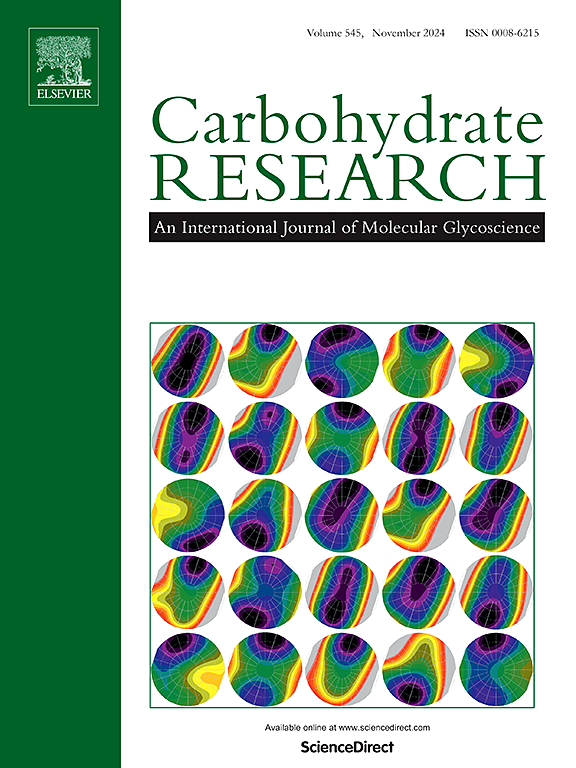Study on the thermal decomposition characteristics of different carbohydrates by TG-FTIR-GC/MS
IF 2.5
3区 化学
Q3 BIOCHEMISTRY & MOLECULAR BIOLOGY
引用次数: 0
Abstract
Thermal decomposition of carbohydrates plays a critical role in various technological fields, including biomass energy conversion, thermal food processing, and the synthesis of functional carbon materials. This study investigated the thermal decomposition of carbohydrates at a high heating rate in both inert (N2) and oxidative (air) atmospheres. The analysis was performed using thermogravimetric analysis (TGA) coupled with Fourier-transform infrared spectroscopy (FTIR) and gas chromatography-mass spectrometry (GC/MS). This approach enables the simultaneous detection of small-molecule gases and organic volatiles. Each carbohydrate exhibited the same number of pyrolysis stages in both N2 and air. The temperature corresponding to the maximum mass loss rate observed in air was consistently lower than or equal to that in N2. The presence of oxygen promoted pyrolysis reactions, resulting in minimal residual carbon in air. Infrared absorption peaks indicated that the main pyrolysis products of carbohydrates appeared at 400 °C. CO2 was the dominant gaseous product in both atmospheres, with significantly higher yields in air. Other major small-molecule gases evolved included H2O, CO, and CH4. GC/MS analysis identified furans, aldehydes, and ketones as the major organic volatiles, with minor amounts of acids, esters, dehydrated carbohydrates, benzene, phenol, and crotonaldehyde. While furfural was the dominant product in N2, both furfural and 5-hydroxymethyl furfural were identified as the primary products in air. This research investigated the thermal decomposition behavior and characterized the pyrolysis products from carbohydrates at a high heating rate.

TG-FTIR-GC/MS研究不同碳水化合物的热分解特性
碳水化合物的热分解在生物质能转化、食品热加工、功能碳材料合成等各个技术领域都起着至关重要的作用。本研究研究了碳水化合物在惰性(N2)和氧化(空气)气氛下的高升温速率热分解。采用热重分析(TGA)、傅里叶变换红外光谱(FTIR)和气相色谱-质谱分析(GC/MS)进行分析。这种方法可以同时检测小分子气体和有机挥发物。每种碳水化合物在N2和空气中均表现出相同的热解阶段数。在空气中观察到的最大质量损失率对应的温度始终低于或等于N2中的温度。氧气的存在促进了热解反应,导致空气中残留的碳最少。红外吸收峰表明,碳水化合物的主要热解产物出现在400℃。在两种大气中,CO2是主要的气态产物,在空气中的产率明显更高。其他主要的小分子气体包括H2O、CO和CH4。GC/MS分析发现呋喃、醛类和酮类是主要的有机挥发物,少量的酸、酯、脱水碳水化合物、苯、酚和巴豆醛。在N2条件下,糠醛为主要产物,而在空气条件下,糠醛和5-羟甲基糠醛均为主要产物。研究了碳水化合物在高升温速率下的热分解行为,并对热解产物进行了表征。
本文章由计算机程序翻译,如有差异,请以英文原文为准。
求助全文
约1分钟内获得全文
求助全文
来源期刊

Carbohydrate Research
化学-生化与分子生物学
CiteScore
5.00
自引率
3.20%
发文量
183
审稿时长
3.6 weeks
期刊介绍:
Carbohydrate Research publishes reports of original research in the following areas of carbohydrate science: action of enzymes, analytical chemistry, biochemistry (biosynthesis, degradation, structural and functional biochemistry, conformation, molecular recognition, enzyme mechanisms, carbohydrate-processing enzymes, including glycosidases and glycosyltransferases), chemical synthesis, isolation of natural products, physicochemical studies, reactions and their mechanisms, the study of structures and stereochemistry, and technological aspects.
Papers on polysaccharides should have a "molecular" component; that is a paper on new or modified polysaccharides should include structural information and characterization in addition to the usual studies of rheological properties and the like. A paper on a new, naturally occurring polysaccharide should include structural information, defining monosaccharide components and linkage sequence.
Papers devoted wholly or partly to X-ray crystallographic studies, or to computational aspects (molecular mechanics or molecular orbital calculations, simulations via molecular dynamics), will be considered if they meet certain criteria. For computational papers the requirements are that the methods used be specified in sufficient detail to permit replication of the results, and that the conclusions be shown to have relevance to experimental observations - the authors'' own data or data from the literature. Specific directions for the presentation of X-ray data are given below under Results and "discussion".
 求助内容:
求助内容: 应助结果提醒方式:
应助结果提醒方式:


